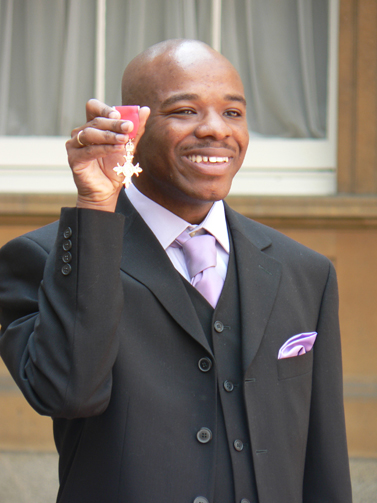As a child, famous architectural artist Stephen Wiltshire, did not speak. His diagnosis of autism was accompanied by a lack of language but an incredible talent for art. His instructors at the Queensmill School noticed his love of drawing and used art supplies as tools to allow him to speak. His first word, at the age of five, was “paper.” Wiltshire's talent was quickly recognized and cultivated. At the age of eight, Wiltshire received his first commission from the British Prime Minister to make a drawing of the Salisbury Cathedral. From there, he would go on to visit cities all over the world, strike up a lifelong friendship with Oliver Sacks, become the subject of multiple documentaries, and publish books filled with his drawings.

Now, Wiltshire is a world-renowned artist and has received the MBE, an order of chivalry granted to British citizens by the reigning monarch for their contributions to the arts or science. He is known for his ability to reproduce entire cityscapes and landmarks from memory. One of his most famous works is a five-meter-long canvas of the entire New York cityscape drawn from memory after a helicopter tour of the city he considers his “spiritual home.” These drawings demonstrate his ability to capture methodically and with precise detail the shapes of buildings, their positions in relation to one another, and even the number of windows, doors, and chimneys.
http://www.stephenwiltshire.co.uk/biography.aspx
With regard to his creative process, it’s difficult to describe how he makes these architectural drawings beyond saying that he does it from memory. Wiltshire will spend time looking at a particular building or scene, occasionally make quick sketches, and move quickly to the canvas to recreate everything he has seen. As mentioned, his memory is incredibly precise. He is able to look at a particular building and automatically count how many floors, windows, doors, etc. the building has. When he describes this, it seems to him that this is the most natural way to think. It is difficult to conceive of a different way to take in the world. This relates to Oliver Sacks’ article about autism and creativity. In it, he describes the experience of Temple Grandin, a famous autistic author and professor of Animal Science. She, like Wiltshire, is a visualizer. She can focus and imagine how livestock can be prepared for slaughter and can internalize the experience of these animals. Moreover, Grandin has a hard time understanding how people don’t think like this. For both Grandin and Wiltshire, the intense visual memory that comes with their particular experiences of autism helps them to achieve incredible creativity in their vastly different fields.
As Wiltshire continues his illustrious career as an artist, the world has a chance to better understand mental health and creativity. His story is an example of resources and well-trained teachers allowing an autistic person's natural talent to thrive. As our society continues to grapple with issues of mental health and the spectrum of autism, we can look at Wiltshire and his beautiful works of art as inspiration and motivation to continue working for better understanding and accessibility.
"An Anthropologist on Mars," Oliver Sacks
"Stephen Wiltshire - The Human Camera" https://www.youtube.com/watch?v=xcX-Nvm-wmE&t=252s
http://www.stephenwiltshire.co.uk/biography.aspx
I have stumbled upon the video of Wiltshire drawing the New York skyline from memory and was absolutely captivated. Stephen’s sister describes him the best in the video as an autistic, artistic savant. I find it extremely interesting that people simply think in different ways especially in the cause of autism. Both Grandin and Wiltshire demonstrate a unique pattern of thinking, specifically memory or recall. I believe Wiltshire is an example of the phenomenon known as “photographic memory,” but I honestly cannot imagine what that is like because I have not and will not ever experience it. I wonder though, is Stephen innately creative because of his unique memory or did is childhood loneliness shape his artistic abilities?
ReplyDeleteI think that Wiltshire is absolutely amazing. His works are incredible and are done with great detail. I cannot believe that he can remember how many windows there were in every building. Like his sister, I too would like to find out how he sees the world and what he envisions in his mind as he translates his memory onto paper through his drawings. His story reminds me a lot of Einstein. Their stories are similar because they both did not speak until later on in life. Many people view autism as a disability, but these individuals may just have a different way of communicate how they experience the world.
ReplyDeleteWiltshire's work is beautiful and his story is captivating! One thing that came to mind while reading this is that if Wiltshire is recording exact reiterations of what he sees through memory, is it really creative? I guess here the creativity is not in the product itself, but how an artist sees paper as a medium for creating images that make someone feel. His works are very powerful, and I love that he takes a process that in his mind is probably fairly simple and shares its beauty with others.
ReplyDeleteIt is a really interesting idea to analyze the cross-section of mental illness and creativity since there is a broad affect of illness on creativity. It can be surprisingly positive like where you have some patients of autism or Asperger having a range of induced increased mental abilities. At the same time it can be debilitating where some mental illness severely effect the patients mental prowess, such as autism patients with severely decreased IQ’s or dementia. One great comparison to Wiltshire, whose artistic ability is complemented by his autism induced visualization prowess, is William Utermohlen. William Utermohlen was a UK artist who due to dementia steadily lost the ability to express his art because of the debilitating effects of dementia started interfering with his ability to visualize, and express (you can actually see the frustration he has in himself as you see his self-portait from when he had dementia).
ReplyDelete